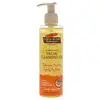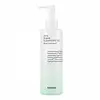What's inside
What's inside
 Key Ingredients
Key Ingredients

 Benefits
Benefits

 Concerns
Concerns

 Ingredients Side-by-side
Ingredients Side-by-side

Glycine Soja Oil
EmollientPrunus Amygdalus Dulcis Oil
Skin ConditioningPolysorbate 85
EmulsifyingPrunus Armeniaca Kernel Oil
MaskingSorbitan Trioleate
EmulsifyingSesamum Indicum Seed Oil
EmollientSimmondsia Chinensis Seed Oil
EmollientTheobroma Cacao Seed Butter
EmollientOryza Sativa Bran Oil
EmollientArgania Spinosa Kernel Oil
EmollientVitis Vinifera Seed Oil
EmollientTocopheryl Acetate
AntioxidantAscorbyl Palmitate
AntioxidantParfum
MaskingBenzyl Benzoate
AntimicrobialBenzyl Alcohol
PerfumingCoumarin
PerfumingGlycine Soja Oil, Prunus Amygdalus Dulcis Oil, Polysorbate 85, Prunus Armeniaca Kernel Oil, Sorbitan Trioleate, Sesamum Indicum Seed Oil, Simmondsia Chinensis Seed Oil, Theobroma Cacao Seed Butter, Oryza Sativa Bran Oil, Argania Spinosa Kernel Oil, Vitis Vinifera Seed Oil, Tocopheryl Acetate, Ascorbyl Palmitate, Parfum, Benzyl Benzoate, Benzyl Alcohol, Coumarin
Ethylhexyl Palmitate
EmollientSorbeth-30 Tetraoleate
EmulsifyingTriethylhexanoin
MaskingGlycine Soja Oil
EmollientCaprylic/Capric Triglyceride
MaskingSimmondsia Chinensis Seed Oil
EmollientCitrus Aurantifolia Oil
CleansingCitrus Limon Peel Oil
MaskingCitrus Aurantium Bergamia Fruit Oil
MaskingTocopherol
AntioxidantHelianthus Annuus Seed Oil
EmollientCaprylyl Glycol
EmollientEthylhexylglycerin
Skin ConditioningAvena Sativa Kernel Oil
Skin ConditioningOlea Europaea Fruit Oil
MaskingOenothera Biennis Oil
EmollientPersea Gratissima Oil
Skin ConditioningPrunus Amygdalus Dulcis Oil
Skin ConditioningWater
Skin Conditioning1,2-Hexanediol
Skin ConditioningCentella Asiatica Extract
CleansingCentella Asiatica Leaf Extract
Skin ConditioningCentella Asiatica Root Extract
Skin ConditioningPinus Pinaster Bark Extract
AntioxidantAsiaticoside
AntioxidantAsiatic Acid
Skin ConditioningMadecassoside
AntioxidantMadecassic Acid
Skin ConditioningEthylhexyl Palmitate, Sorbeth-30 Tetraoleate, Triethylhexanoin, Glycine Soja Oil, Caprylic/Capric Triglyceride, Simmondsia Chinensis Seed Oil, Citrus Aurantifolia Oil, Citrus Limon Peel Oil, Citrus Aurantium Bergamia Fruit Oil, Tocopherol, Helianthus Annuus Seed Oil, Caprylyl Glycol, Ethylhexylglycerin, Avena Sativa Kernel Oil, Olea Europaea Fruit Oil, Oenothera Biennis Oil, Persea Gratissima Oil, Prunus Amygdalus Dulcis Oil, Water, 1,2-Hexanediol, Centella Asiatica Extract, Centella Asiatica Leaf Extract, Centella Asiatica Root Extract, Pinus Pinaster Bark Extract, Asiaticoside, Asiatic Acid, Madecassoside, Madecassic Acid
Ingredients Explained
These ingredients are found in both products.
Ingredients higher up in an ingredient list are typically present in a larger amount.
Glycine Soja Oil comes from the soybean. Glycine Soja is native to eastern Asia.
Soybean oil is an emollient. It is rich in antioxidants and fatty acids including palmitic, stearic, oleic, and linoleic acids.
As an emollient, the fatty acids in soybean oil helps keep your skin soft and hydrated. It does so by creating a film on top that traps moisture in.
Soybean oil is also rich in vitamin E, a potent antioxidant. Vitamin E is also anti-inflammatory and provides a soothing effect.
Studies show soy may help fade hyperpigmentation from UVB. It does so by disrupting the melanin process from UVB induced skin inflammation.
This ingredient may not be malassezia folliculitis, or fungal-acne, safe.
Soybeans are rich in proteins and are part of the legume family. Foods made with soybeans include tofu, soymilk, edamame, miso, and soy sauce.
Learn more about Glycine Soja OilPrunus Amygdalus Dulcis Oil comes from the sweet almond, a tree native to Iran. This oil has no fragrance and is non-volatile.
Almonds contain healthy fats, vitamins, and minerals. It is a rich source of Vitamin E, a great antioxidant and skin conditioning ingredient. Sweet almond oil contains fatty acids such as linolenic acid and triglycerides.
The content of sweet almond oil makes it a great emollient; it can help soften and hydrate your skin. Emollients create a barrier over your skin to trap moisture in. Sweet almond oil has antioxidant properties.
Those with an almond allergy should be careful of this ingredient and speak with a professional about using it in your skincare.
This ingredient may not be fungal-acne safe.
Learn more about Prunus Amygdalus Dulcis OilThis oil comes from the seeds of the desert shrub called Jojoba. It is more commonly known as jojoba oil, a non-comedogenic oil.
Jojoba oil does not contain fragrance and has many fatty-acids, making it a great soothing ingredient.
It also contains Vitamin E, a great moisturizing ingredient. Vitamin E is also an antioxidant and protects your skin against oxidative damage.
This ingredient humectant properties, meaning it helps draw moisture from the air. This helps keep your skin hydrated.
While jojoba has antibacterial properties, it is only able to kill some strains of bacteria.
Studies also show it helps in wound healing. In fact, Indigenous cultures have used jojoba as a moisturizer and to help treat burns for centuries.
Fun fact: Jojoba oil similar to natural human skin sebum, so it has a great effect on dry skin. It is also promising with helping to regulate sebum production.
Due to its fatty acid content, Jojoba oil may not be fungal acne safe. We recommend speaking with a professional if you have any concerns.
Learn more about Simmondsia Chinensis Seed Oil